Pre History
Exploration and Early Settlement of Massachusetts
+ Expand All
1620
- Landing at Plymouth
-
1620-12-20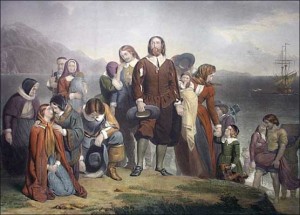
Although explorers had touched down before, a small group of Pilgrims -- most from Yorkshire- were the first permanent settlers in Massachusetts
1630
- The Great Migration
-
1630
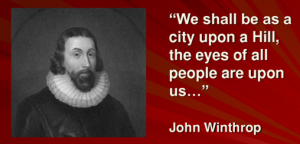
1630-1642 - Under increasing religious persecution, about 20,000 men, women and children from East Anglia came to what is now the Boston area. The first "fleet" was organized by John Winthrop who became governor. At the time Lenox was formed, most residents would have traced their linage to this group of early settlers. The migration came to an end with the English Civil War that ended in the beheading of Charles I.
Massachusetts as a Royal Colony
+ Expand All
1755
- Flight to Stockbridge
-
1755In fear of an Indian raid (really just an outlaw) residents from what would become Lenox north fled to the relative safety of Stockbridge. Although this incident was a false alarm, the fear of Indian raids was a major brake on development of Massachusetts west of the Berkshires.
Formation of Berkshire County and the Road to Revolution
+ Expand All
1760
- George III Becomes King
-
1760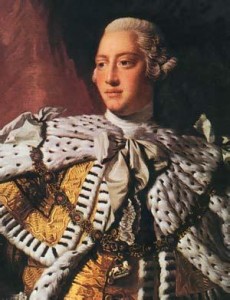
When he ascended the throne the king who was to oversee the loss of the thirteen American colonies was only 22 years old. He went on to reign for 59 years -- one of England's longest reigning monarchs.
1761
- Formation of Berkshire County
-
1761-04-24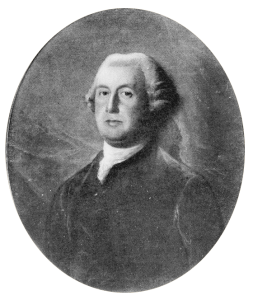
Anxious to establish a border with the New York colony and to generate revenue from land sales, Governor Francis Bernard separated the western half of Hampshire County to form Berkshire County (named for his birth county in England).
1765
- Stamp Act
-
1765-03-22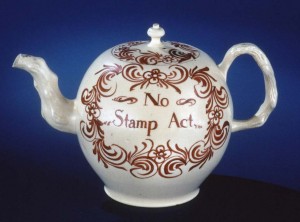
The Stamp Act was one of a series of attempts by the Lords of Trade to cover the costs of maintaining a standing army in North America. With a bit of tea party foreshadowing, colonists protested in writing and with merchandise (above). The act was repealed a year later and turned out to be a rehearsal for even more well organized colonial protests to follow.
1766
- Petition to Split Lot 8
-
1766-07-06Mt. Ephraim and Yokuntown (Richmond and Lenox) petitioned the General Court to be allowed to incorporate as two towns in recognition of the mountain range running through Lot #8.
1769
- The First Meeting House
-
1769-07-26Lenox voted to appropriate funds to build a meeting house on land "sequestered" by Rev. Peter Reynolds - near the current Church on the Hill. Later town votes indicate the building was still in progress in 1770 when Rev. Samuel Monson was called to preach.
1770
- Boston Massacre
-
1770-03-05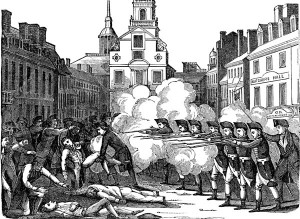
In addition to attempting (unsuccessfully) to extract revenue from the colonists, Parliament expected the colonists to quarter the standing army they now maintained in Boston and elsewhere in the colonies. Although it's not clear who fired first, tensions had risen to the point where rock throwing civilians led quickly to shots from armed soldiers.
1772
- Committees of Correspondence
-
1772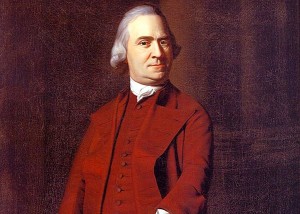
Samuel Adams organized Committees of Correspondence in which towns - and colonies - agreed to keep each other informed and to coordinate their protests against Parliamentary taxation and abrogation of colonial laws and privileges.
1773
- Townsend Duties and the Tea Tax
-
1773-05-10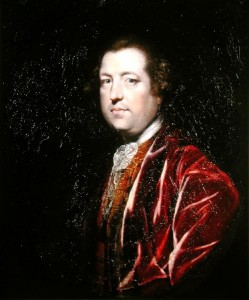
Chancellor of the Exchequer Charles Townsend kept trying to come up with creative ways to generate revenues from the colonies. Like many in the inner circles of government, he failed to recognize the growing anger and focused protest these policies were generating. Most of the Townsend duties were repealed--except for the tax on tea.
- Boston Tea Party
-
1773-12-10
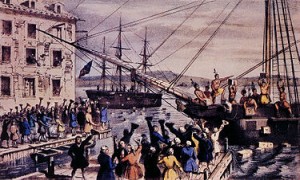
Although tea dumping - in protest of the tax levied on tea - occurred elsewhere, the most famous occurrence was in Boston harbor.
1774
- Intolerable Acts
-
1774-03-31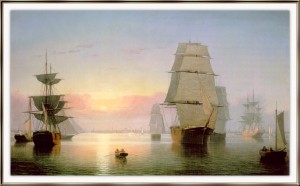
In reaction to the Boston Tea Party, Parliament enacted what the colonists called "The Intolerable Acts," which included closing the port of Boston, overriding the elected chamber of the colony's government, limiting town meetings and requiring colonists to accept judges appointed by the royal governor.
- Berkshire Convention in Stockbridge
-
1774-07-06
John Patterson, William Walker and others from Lenox gathered with the rest of the county at the Red Lion Inn (Bingham's Tavern at the time) to agree on language and actions for a non-importation agreement--boycotting trade from Britain.
- Great Barrington Court Protests
-
1774-08-16Fifteen hundred unarmed men from Berkshire County and Litchfield County, CT., rallied to shut down the county court meeting in Great Barrrington in protest of judges appointed by the unrecognized royal government.
- Lenox Signs Non-Importation Agreement
-
1774-10-10More than 100 residents of the frontier town of Lenox agreed to boycott British goods (along with towns across the colonies). The highly organized protest was effective at blocking trade, but its impact was truncated by the active fighting touched off by British raids on Lexington and Concord.
1775
- Shot Heard Round the World
-
1775-04-19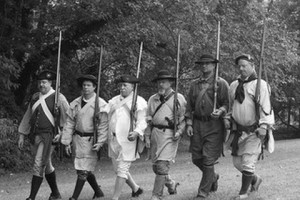
Very shortly after the first shots of the Revolutionary War were fired in Lexington and Concord, an express rider delivered the news and Lenox's minute men marched off to Boston.
From Revolution to Republic
+ Expand All
1775
- Battle of Bunker Hill
-
1775-06-17Although the colonials did not gain ground, in the first major battle of the war, Bunker (Breeds) Hill is often considered an American victory because of the British lives lost and the fierce American defense. John Paterson and the Lenox minutemen manned Charleston Heights during this battle.
1777
- Surrender of Burgoyne at Saratoga
-
1777-10-07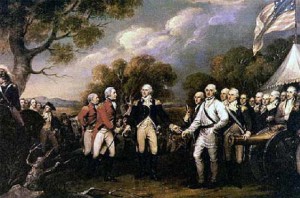
The defeat of Burgoyne was a major turning point for the colonials. The Berkshires were well represented with a unit of militia under Parson Allen of Pittsfield the first to arrive at Bennington and John Paterson leading the Battle of Bemis Heights.
1778
- Battle of Monmouth
-
1778-06-28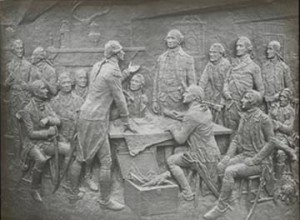
This relief from the Battle of Monmouth Monument shows Gen. Paterson sitting opposite George Washington at the pre-battle council.
1780
- Hardship at Home
-
1780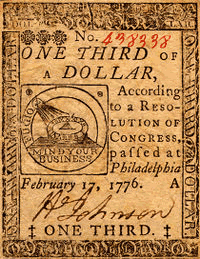
Inflation and shortages were terrible for the civilians left at home as well as the soldiers. By 1780 the dollars issued by the Continental Congress were worth only 1% of their face value.
- Massachusetts State Constitution
-
1780-06-15The first Massachusetts state constitution was written largely by John Adams and informed the structure of the U.S. Constitution which was to be written eight years later. William Walker represented Lenox in the discussions.
- Betrayal of Benedict Arnold
-
1780-09-20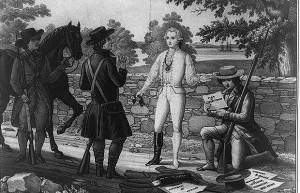
The capture of British Major John Andre (pictured) revealed Arnold's treason. Arnold escaped but Andre did not. Gen. Paterson participated in his trial.
1782
- Lenox Chosen as County Seat
-
1782-09-01
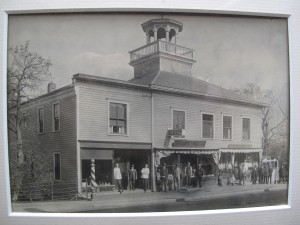
The first courthouse (pictured) wasn't completed until 1791, but Lenox remained the county seat until 1867.
1783
- Lenox Dale Furnace
-
1783-06-09The Tucker MS reports 500 acres of the Larabee Grant (encompassing modern day Lenox Dale) being granted to Charles Goodrich of Pittsfield. The earliest date of a furnace operating is listed as 1783. At the time, the operation was apparently owned by Job Gilbert of Bistol, MA.
- Treaty of Paris Ends Revolutionary War
-
1783-09-03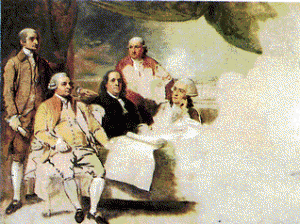
In signing the Treaty of Paris the British opened the area of west of the Appalachians to American settlement and agreed to remove British troops. The British signers refused to sit for their part of the famous portrait shown here.
1787
- Northwest Ordinance
-
1787 The Continental Congress formalized settlement of the Ohio River Valley and the midwest. The ordinance proscribed land division, schools and the conditions for statehood. Many Lenox families would end up with descendants in Ohio.
- Lenox Dale Furnace Syndicataion
-
1787-02-15William Walker gathered subscriptions from 51 Lenox and Lee residents to buy out the furnace--an illustration of the early transition to manufacturing and a money-based economy.
- Shay's Rebellion Ends in Sheffield
-
1787-02-27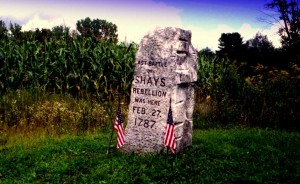
By 1787 the rebels had failed in their assault on the arsenal at Springfield, in their attempt to shut down the courts in Great Barrington, and in a raid on Stockbridge, Major Ashley and General Patterson fought the last action against them (noted in the marker shown here) in Sheffield. Later in the year two men (who may have just been burglars) were hung in Lenox for their role in the rebellion.
1789
- US Constitution Signed in Philadelphia
-
1789-09-17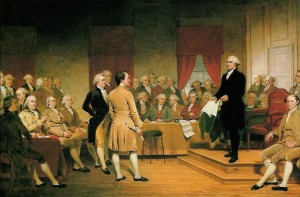
Shay's Rebellion heightened awareness of the inadequacy of the Articles of Confederation. Eleven states ratified the Constitution in March 1789; George Washington was inaugurated as the first President two months later.
Early Republic and Shiretown Era
+ Expand All
1803
- Lenox Academy
-
1803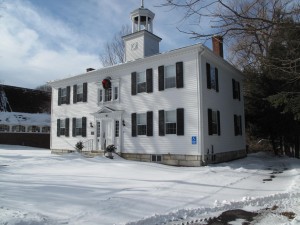
Pupils came from as far away as Georgia to attend the Lenox Academy (pictured here) which would have been a great source of pride to this small town.
- Louisiana Purchase
-
1803-04-30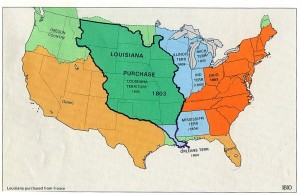
The Louisiana Purchase added all of part of what would become 15 states at a cost of about 4 cents/acre. The new territories made both sides of the Mississippi attractive to land-hungry New Englanders.
1805
- Church on the Hill
-
1805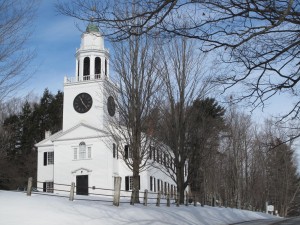
The new Federalist style church replaced the earlier meeting house nearby. It is on the National Register of Historic Places.
- Second Great Awakening
-
1805A revival meeting was held this year in Lenox. It was part of a more populist religious movement that began shortly after the revolution. The direct result in Lenox was incorporation of the Methodist Church in Lenox in 1811; church at the corner of Church and Franklin dedicated 1834.
1815
- New Courthouse
-
1815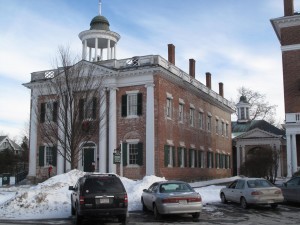
Lenox was the county seat until 1868. Being the home of the county's lawyers and judges contributed to Lenox's early culture. After the court was moved to Pittsfield, the former courthouse became the Sedgewick Library.
1825
- Erie Canal Completed
-
1825-10-26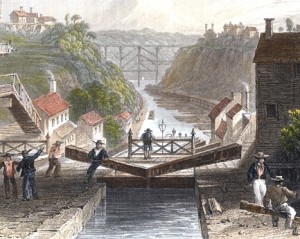
By opening a route from the Great Lakes to the Atlantic via the Hudson River, the Erie Canal made New York City a trading capital and provided a way to the Ohio River Valley, Illinois and Michigan for land hungry New Englanders.
1830
- Shaker Communities
-
1830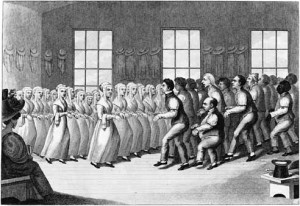
The Shakers, an offshoot of the Quakers, established Hancock Shaker Village (now open to the public) in 1791 under the leadership of "Mother" Ann Lee. At its peak 1820-1840, Shakerism was consistent with the overall religious revival.
1844
- Telegraph
-
1844
- Samuel Gray Ward Builds Highwood
-
1844-03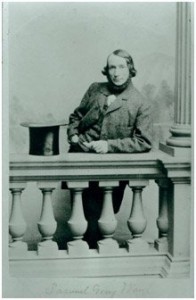
Samuel Gray Ward was of the new international class of Americans, involved in investment banking, the arts, and the first --others would follow- of a group of wealthy Boston families seeking rustic culture in the Berkshires.
1850
- Hawthorne in Lenox
-
1850-05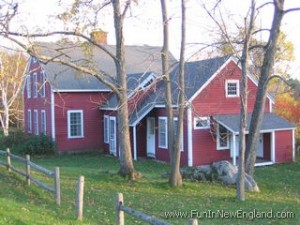
After completing "The Scarlet Letter," Hawthorne moved his family to a simple (and cold) Berkshire farmhouse on Stockbridge bowl. He lived here until November 1851 and, while here, interacted with Herman Melville, Fanny Kemble, the Sedgewicks -- and wrote "The House of the Seven Gables," and "The Wonder Book".
1851
- Moby Dick
-
1851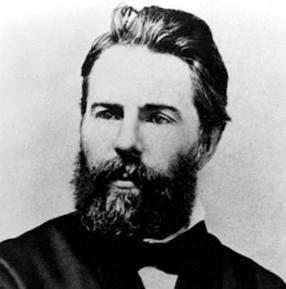
Herman Melville moved his family to Pittsfield (Arrowhead - now open to the public) in August 1850. He had almost finished "Moby Dick" by the time he settle here, but after discussing the symbolism of "The Scarlet Letter" with Hawthorne, he re-wrote it completely and published the next year.
1853
- Lenox Dale Adds Glass Works
-
1853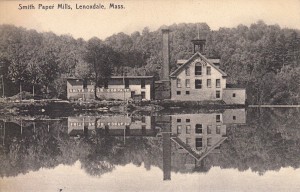
By the end of the 19th century the manufacturing complex in Lenox Dale would have tried to use the water power and furnace available to them to make iron (from the ore dug up under the town and Lenox Mountain), glass and paper. By the end of the 19th century, they also would have found that other areas had the power and transport ion to do all more efficiently.
1858
- Transatlantic Cable
-
1858-08-16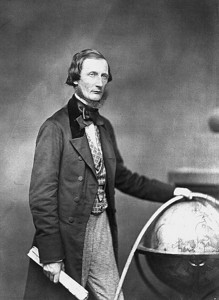
Cyrus West Field (born in Stockbridge, MA in 1819) led effort to lay transatlantic cable that reduced the time to transmit communications across the Atlantic from ten days to minutes.
Gilded Age
+ Expand All
1869
- Transcontinental Railroad Opened
-
1869-05-10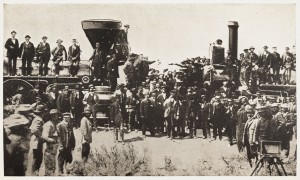
The meeting of the Union Pacific and the Southern Pacific at Promintory Point Utah not only opened the market for western commodities and trade, but demonstrated a new scale in construction and manufacturing.
- Westinghouse Air Brake Co. Organized
-
1869-07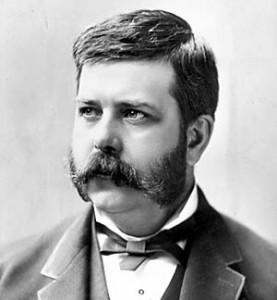
George Westinghouse would go on to build the Niagara Falls generators, form General Electric and produce numerous other inventions that contributed to the age of electricity. He also built and lived in Erskine Park, destroyed and replaced by Foxhollow.
1886
- President Chester Arthur - New Trinity Dedication
-
1886
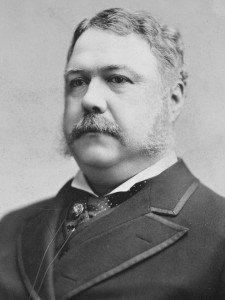
Chester Arthur would have been the ex-President by this time and Frederick Freylinghuysen, who lived across the street at what is now the Kemble Inn, had been his Secretary of State.
- Elm Court Built
-
1886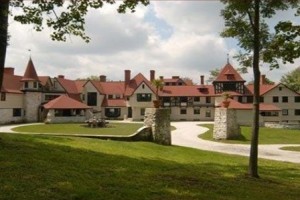
William Douglas Sloan built Elm Court between 1886 and 1900. His brother John built Wyndhurst (now Cranwell) in 1892.
- Great Barrington Electrified
-
1886-03-20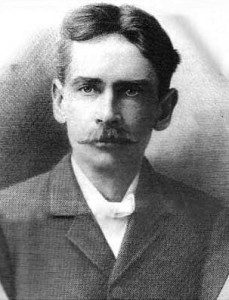
William Stanley, Jr. invented the transformer and electrified downtown Great Barrington to demonstrate the safety of the transformer and the use of alternating current (AC). He made Pittsfield an Age of Electricity equivalent to today's Silicon Valley. Stanley Electric merged with Westinghouse to form General Electric.
1892
- Homestead Steel Strike
-
1892-06-30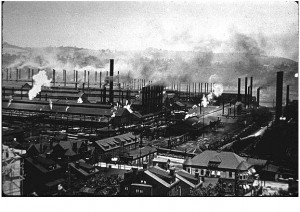
The Homestead Steel Plant (owned by Andrew Carnegie who summered at Shadowbrook) was the site of a violent strike. Pay was low and working conditions were terribly dirty and dangerous.
1893
- Shadowbrook
-
1893
Anson Phelps stokes completed Shadowbrook. With 100 rooms it was the largest house in America for two years -- until George Washington Vanderbuilt completed his 250 room mansion -- Biltmore. It burned in 1956.
- Ventfort Hall
-
1893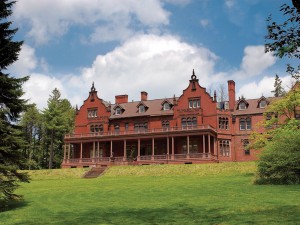
Sarah (sister of J.P. Morgan) and George Morgan built this Jacobean Revival summer house. It was originally surrounded by gardens, two gatehouses and a carriage house.
1902
- TR Injured in Pittsfield
-
1902-09-03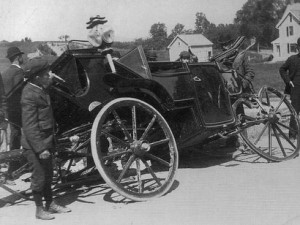
A collision with a streetcar on a campaign trip to Pittsfield killed a secret service agent and injured President Theodore Roosevelt. He spoke to the crowds that had formed at the Curtis Hotel in Lenox where he was staying.
1904
- The Mount
-
1904
Edith Wharton, who became famous writing about the foibles of her social class, built a Lenox cottage with a design modern for its time. It is now open to the public.
20th Century
+ Expand All
1903
- GE Acquires Stanley Electric
-
1903 General Electric would expand to employ more than 15,000 during World War II. GE provided not only well-paid manufacturing jobs but attracted highly educated engineers and other professionals to Pittsfield and nearby communities such as Lenox.
General Electric would expand to employ more than 15,000 during World War II. GE provided not only well-paid manufacturing jobs but attracted highly educated engineers and other professionals to Pittsfield and nearby communities such as Lenox.
1913
- Income Tax
-
1913-02-25The 16th Amendment makes income tax a permanent feature of the economics of the US.
1929
- Donation of Bird Sanctuary
-
1929 Mary Parsons purchased the Power farm and donated it as the Pleasant Valley Bird Sanctuary. It would later be taken over by Mass Audubon.
Mary Parsons purchased the Power farm and donated it as the Pleasant Valley Bird Sanctuary. It would later be taken over by Mass Audubon.
- Lenox School for Boys Opens
-
1929-09-22
The former estate of George G. Haven (Sunnycroft) was the first of several former "cottages" in the village occupied by The Lenox School for Boys. Renamed Griswold Hall, It was demolished in 1938.
1931
- Aspinwall Hotel Burns
-
1931-04
The Aspinwall Hotel was in what is now Kennedy Park facing South and would have had a beautiful view.
1946
- Eastover Becomes a Sports Oriented Resort
-
1946 Lenox also had the good fortune to attract a couple that saw the potential for a youthfully oriented resort in the former Fahnestock Mansion (1910) on East Street. In 1946 George Bisacca purchased the 500 acre property with a vision of a resort for singles (later families as well.) Bisacca made a significant investment in entertainment for the winter months with a rope tow and indoor swimming pool. Currently the facility (Eastover) is, under new ownership, a resort focused on holistic health.
Lenox also had the good fortune to attract a couple that saw the potential for a youthfully oriented resort in the former Fahnestock Mansion (1910) on East Street. In 1946 George Bisacca purchased the 500 acre property with a vision of a resort for singles (later families as well.) Bisacca made a significant investment in entertainment for the winter months with a rope tow and indoor swimming pool. Currently the facility (Eastover) is, under new ownership, a resort focused on holistic health.
1957
- Mass Turnpike Crosses Berkshire County
-
1957-05-15
Completion of the Mass Pike (as well as the rest of the interstate highway system) was a great boon to tourism in the 1950's and 1960's.
1961
- Morris Elementary School
-
1961 In response to population growth, the town invested in a series of capital investments including a new k-6 school on West. St. on land donated by the Morris Family and graced by an original mural by famous cubist George Morris.
In response to population growth, the town invested in a series of capital investments including a new k-6 school on West. St. on land donated by the Morris Family and graced by an original mural by famous cubist George Morris.
1966
- Lenox Memorial High School
-
1966 By 1966 Lenox's need for more classroom space as well as for facilities to support a modern curriculum had exceeded what the former high school (now Cameron House) and the new Lenox Memorial High School was built.
By 1966 Lenox's need for more classroom space as well as for facilities to support a modern curriculum had exceeded what the former high school (now Cameron House) and the new Lenox Memorial High School was built.
- National Preservation Act
-
1966-10-15
1967
- Lenox Bicentennial
-
1967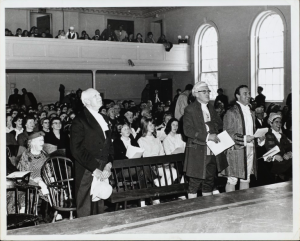
Lenox's bicentennial came at a time of prosperity and optimism for Western Massachusetts
1976
- Bible Speaks Takes Over Lenox School Buildings
-
1976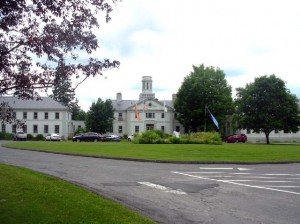
Formerly the site of the Lenox School for Boys, now the site of Shakespeare and Company, this Kemble St. campus and other buildings were, until 1987, the home of Bible Speaks.
1977
- A Bad Idea Averted
-
1977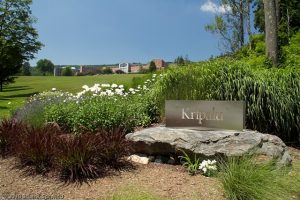 In 1977 the town defeated a proposal to make the site of the former Shadowbrook a prison. Today it is the site of Kripalu, a resort focused on Yoga and healthful living.
In 1977 the town defeated a proposal to make the site of the former Shadowbrook a prison. Today it is the site of Kripalu, a resort focused on Yoga and healthful living.
1978
- Shakespeare and Company Founded
-
1978
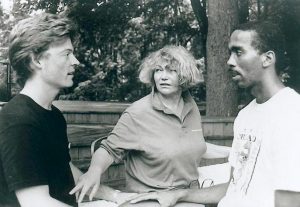 Tina Packer formed Shakespeare and Co. which performed for a number of years at The Mount and took over the Lenox School for Boys/Bible Speaks campus in 2000.
Tina Packer formed Shakespeare and Co. which performed for a number of years at The Mount and took over the Lenox School for Boys/Bible Speaks campus in 2000.
1986
- GE Transformer Plant in Pittsfield Closes
-
1986-11-22Demand for the large transformers made in Pittsfield had declined for years. General Electric was by far the most important employer in the area so the plant closing brought new economic challenges to Lenox and other nearby communities.
1994
- Ventfort Hall Restoration Begins
-
1994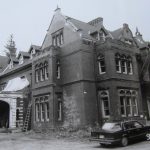 In a severely deteriorated condition, Ventfort Hall was threatened with demolition. Fortunately a group of dedicated volunteers bought the property and took on the challenging work of restoration which goes on today..see the before and after pictured here. Ventfort Hall is now open for year-round tours and events.
In a severely deteriorated condition, Ventfort Hall was threatened with demolition. Fortunately a group of dedicated volunteers bought the property and took on the challenging work of restoration which goes on today..see the before and after pictured here. Ventfort Hall is now open for year-round tours and events.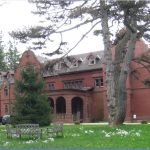
2000
- Shakespeare and Co. Purchases Bible Speaks
-
2000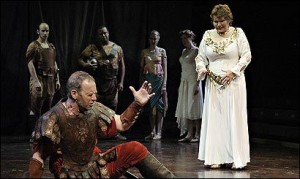 Shakespeare and Company now conducts performances on two stages year round as well as providing educational opportunities for actors and students. The Company, led by Tina Packer bought the former Bible Speaks/Lenox School for Boys campus on Kemble St. in 2000 after performing, starting in 1978, at The Mount.
Shakespeare and Company now conducts performances on two stages year round as well as providing educational opportunities for actors and students. The Company, led by Tina Packer bought the former Bible Speaks/Lenox School for Boys campus on Kemble St. in 2000 after performing, starting in 1978, at The Mount.